UV-C LED Market Size
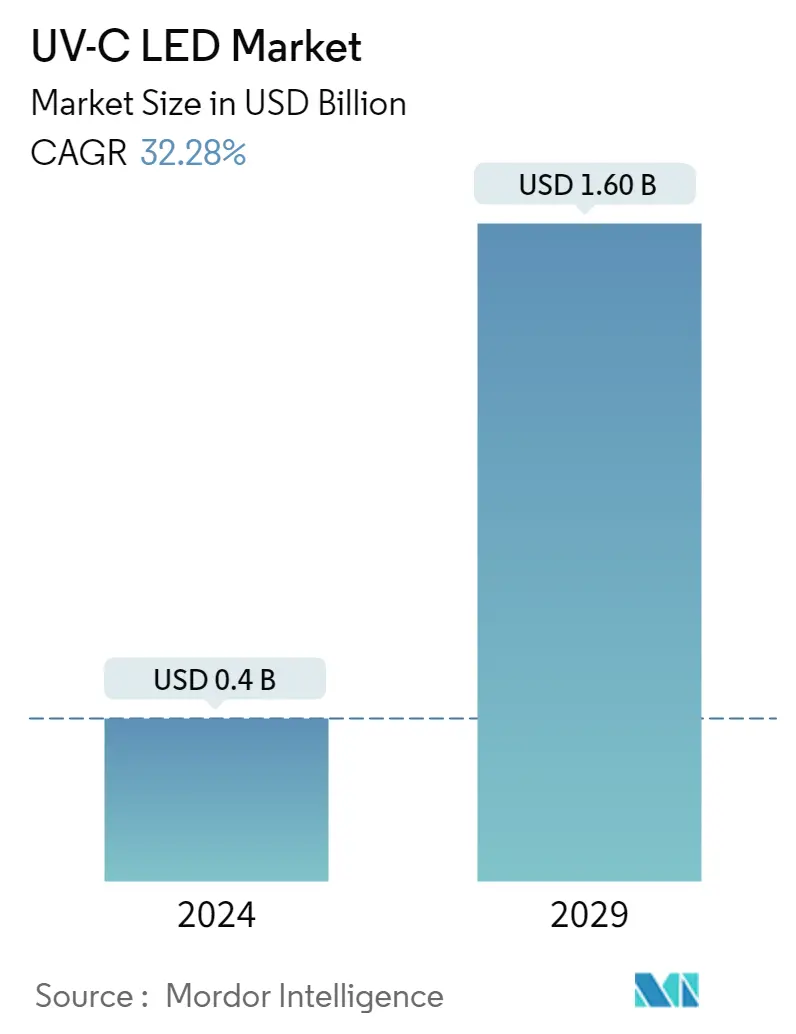
| Study Period | 2018 - 2028 |
| Market Size (2023) | USD 0.3 Billion |
| Market Size (2028) | USD 1.21 Billion |
| CAGR (2023 - 2028) | 32.28 % |
| Fastest Growing Market | North America |
| Largest Market | Asia-Pacific |
Major Players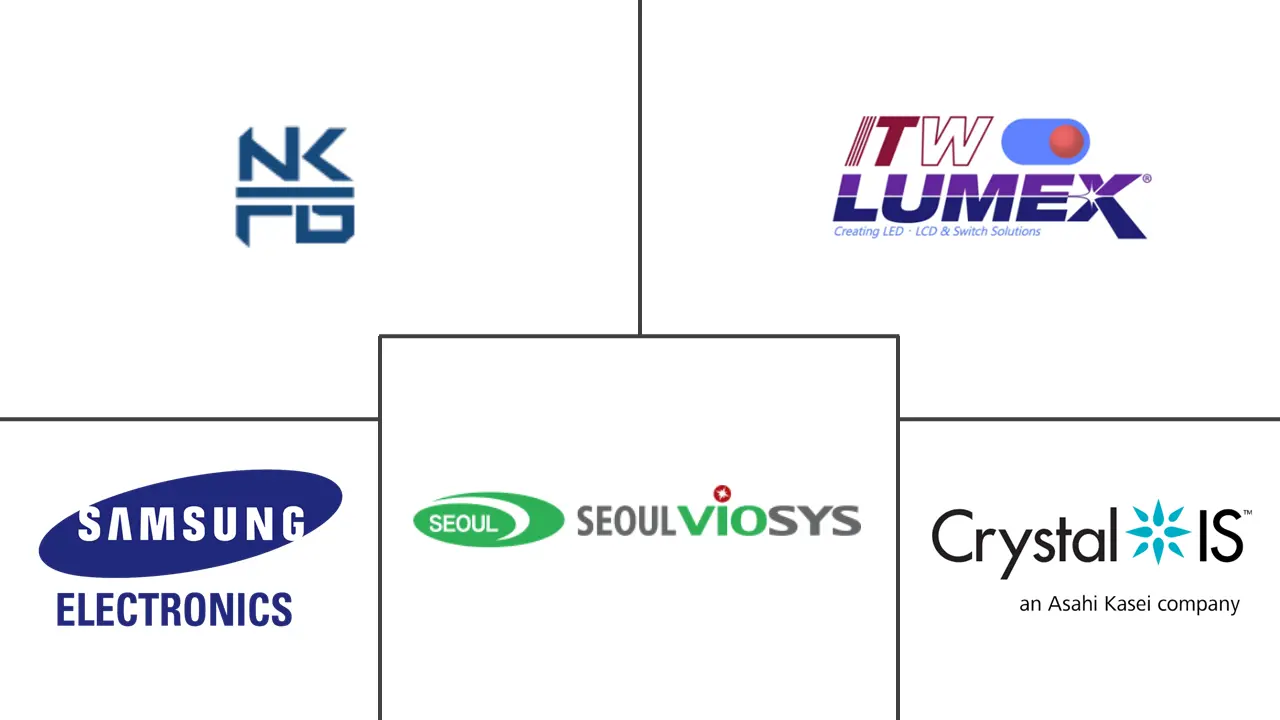
*Disclaimer: Major Players sorted in no particular order |
Need a report that reflects how COVID-19 has impacted this market and its growth?
UV-C LED Market Analysis
The UV-C LED Market size is estimated at USD 0.30 billion in 2023, and is expected to reach USD 1.21 billion by 2028, growing at a CAGR of 32.28% during the forecast period (2023-2028).
UV-C LEDs produce UV photons through the electroluminescence of a semiconductor crystal. These semiconductor crystals are typically made of AlGaN compounds grown on sapphire or AlN substrates. These solid-state devices contain no mercury and do not rely on other substances that are subject to environmental restrictions. As a result, they may provide a regulatory-proof alternative to traditional mercury-containing UV lamps.
- During the forecast period, the incorporation of UV-C LED into consumer goods and home appliances is anticipated to present a significant opportunity for the growth of the UV-C LED market. Improvements in output power and reliability and the recent unit cost price reduction for UV-C LEDs are additional factors significantly fueling the market growth.
- The technology of UV-C LEDs is gradually becoming better. The commercialization of water purification and disinfection has resulted in a sizeable market for the products. This is one of the factors driving UV-C LED demand globally. UV-C LEDs provide a focused wavelength for selective and targeted measurements.
- Moreover, UV-C LEDs offer surface and air disinfection in addition to water. In the commercial environment, the use of UV-C LED air purifiers for HAVC (heating, ventilation, and air conditioning) is rising. UV-C LEDs are finding new services in a wide range of industries, including residential, commercial, healthcare, transportation, life sciences, defense, and emergency response.
- The thermal management of UV-C LEDs is a major problem because the technology is still in its infancy. LEDs are extremely heat-sensitive, just like any other electronic component. UV-C LEDs only convert about 5% of the input power into light, which is a particularly low external quantum efficiency (EQE) for LEDs. Heat is created by converting the remaining 95% of the power.
- The COVID-19 outbreak had affected the expansion of the global UV-C LED market. It sparked a meteoric rise in interest in germicidal ultraviolet (UV) technology. SARS-CoV-2 and other pathogens can be rendered inactive on surfaces, in the air, and in water by UV-C band radiation (100-280 nm) produced by conventional or LED sources. Around the world, numerous universities and laboratories are creating UV-C LED-based products to stop the spread of infections. As a result, COVID-19 boosted the market's growth.
UV-C LED Market Trends
This section covers the major market trends shaping the UV-C LED Market according to our research experts:
Water Disinfection to Drive the Market
- UV-C LEDs provide a safe, efficient method of treating water without the use of risky chemicals that contaminate rivers, oceans, and other bodies of water. UVC-LEDs are used to efficiently purify water in applications such as water reclamation, wastewater treatment, drinking water, industrial and commercial process water, pools and spas, aquaculture, and life sciences.
- Moreover, UV-C LEDs can be added to on-demand POU water purification systems to safeguard households against common pathogenic causes of waterborne illnesses. UV-C LEDs are used in these systems to protect against microbial contaminants, which include parasites, viruses, and bacteria like e. coli, pseudomonas, and legionella.
- There are two types of water disinfection, namely single-pass type and water storage type. A single-pass type irradiates ultraviolet to disinfect running water, such as a household water purification system. A water storage type irradiates and disinfects water inside a water storage tank, such as a humidifier.
- Drinking water is sanitized with UV-C LEDs at various stages of the treatment process, from the source to consumption. With the new technology, LEDs can be positioned at different points to ensure decontamination. In a UV-C model, it can take a few seconds for the water to become clean. It initially functions by disinfecting the water by exposing a reservoir to several powerful LEDs. They release potent UV-C photons between 200 nm and 280 nm, which travel through the water and prevent aquatic bacteria from being able to procreate.
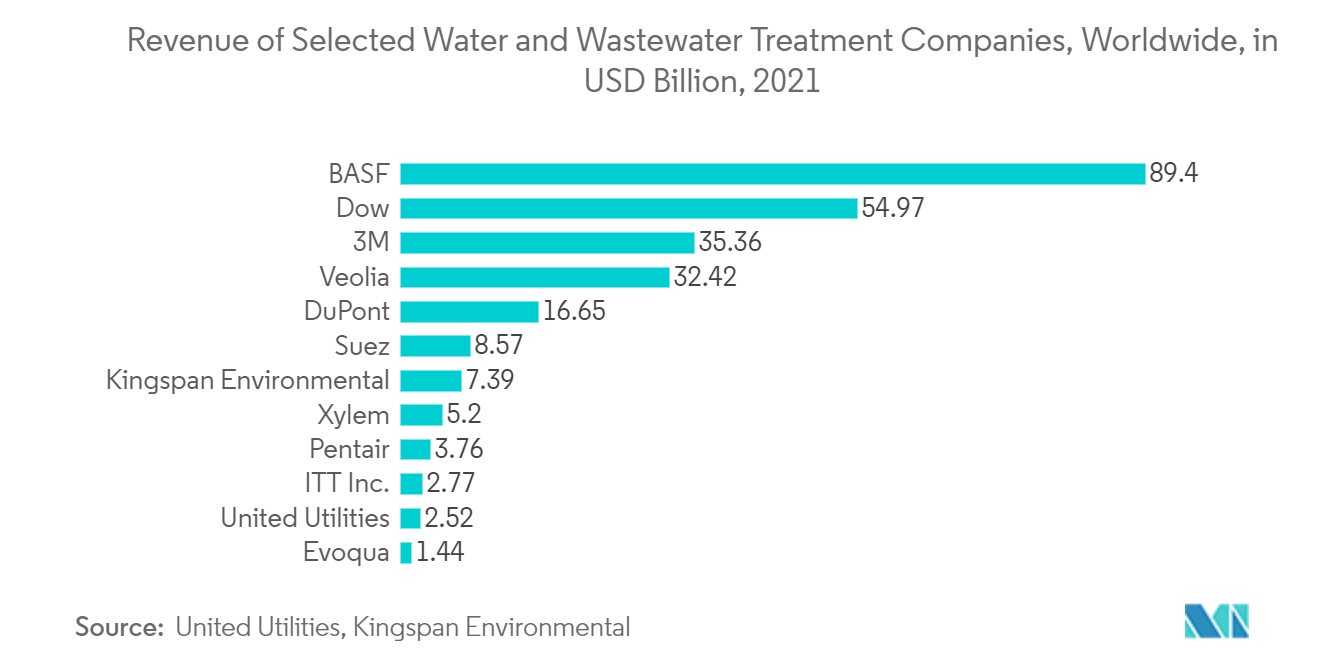
Asia-Pacific Accounts for the Largest Market Share
- Geographically, the UV-C LEDs market in Asia-Pacific is expected to hold the most prominent market share during the forecast period because the main UV-C LED suppliers are in South Korea and Japan. Moreover, the region is also experiencing a rise in the demand for UV-C LEDs for scientific research. It is anticipated that several South Korean LED companies are going to launch new series of UV-C LED products contributing to expanding the revenue of South Korean suppliers.
- Increasing cases of water-borne diseases, primarily in emerging countries across Asia, are poised to augment demand as UV radiation holds a strong germicidal ability to disinfect water with protozoans, bacteria, and viruses. The market growth is stimulated by the increasing adoption of advanced technologies to treat industrial liquid waste and wastewater.
- Leading companies are offering high-performance solutions for large-volume applications like industrial water treatment and municipal drinking water. In addition, factors such as government policies, rapid industrialization, and a strong focus on efficient water and wastewater treatment are poised to expedite the growth of the market.
- The growth of the market is also favored by the increasing adoption of UV-C LED-based equipment in the healthcare industry. These devices can be effectively designed and customized for patient wards, operating rooms, and other areas for efficient disinfection and mitigating the risk of hospital-acquired infections.
- The water and wastewater treatment segment is witnessing growth owing to increased acceptance of both municipal as well as household drinking water treatment systems across Asian countries such as Nepal, Bhutan, Bangladesh, and India. The water treatment segment, which includes municipal, commercial, and residential applications, dominates the UV disinfection equipment market.
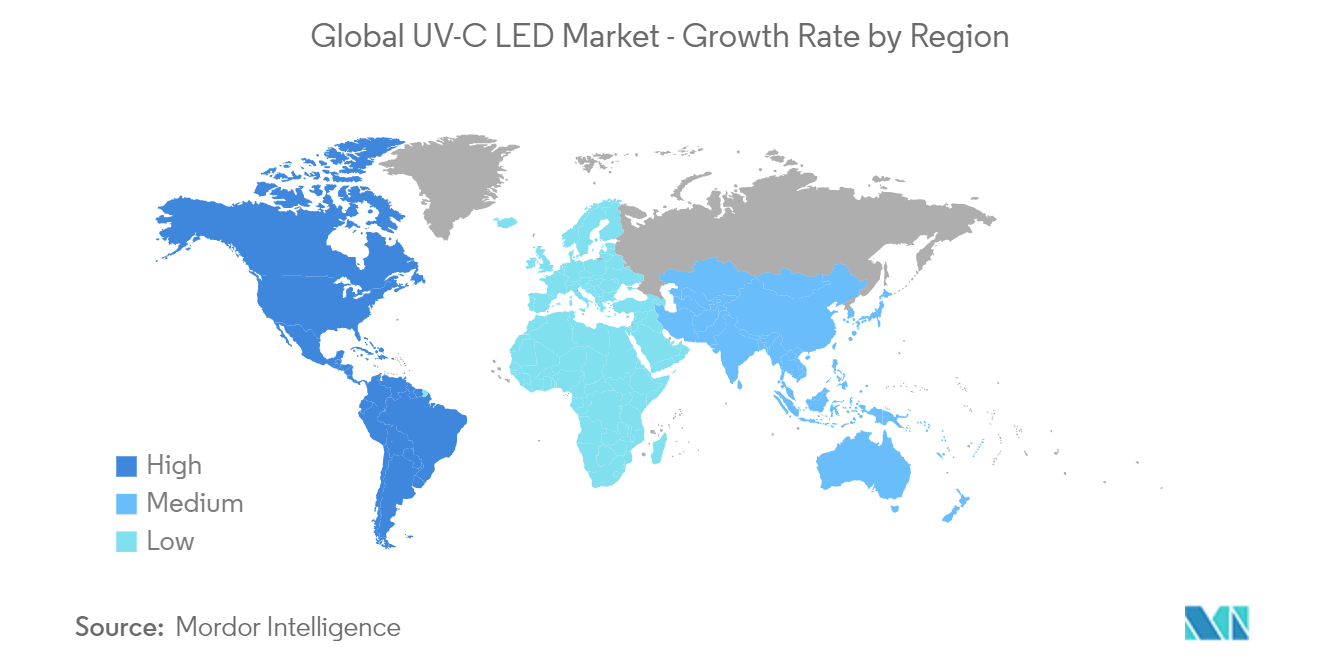
UV-C LED Industry Overview
The UV-C LED market is fragmented and consists of major players. In terms of market share, no company has absolute control over the market, and everyone has their fair share. Major players include NKFG Corporation, Nitride Semiconductor Co. Ltd, Samsung Electronics Co. Ltd, Lumex Inc. (ITW Inc.), and Crystal IS Inc. (Asahi Kasei Group).
- October 2022: Asahi Kasei, the parent company of Crystal IS Inc., demonstrated how the UV-C LED technology could be applied to achieve higher disinfection efficiency in water treatment than conventional mercury lamp systems. Crystal IS and Asahi Kasei's advancements in UV-C LED (light-emitting) technology contribute majorly to society's sustainability and are essential steps toward actualizing a mercury-free world.
- September 2022: AMS-OSRAM complemented its high-power UV-C LED portfolio for purification applications. Osram's OSLON UV 6060 offers powerful 100 milliwatts out of a single die source at 265 nanometers. The emission wavelength provides the highest germicidal effectiveness. The OSLON UV 6060 from AMS-OSRAM meets the needs of industrial applications delivering sustainable UV-C treatment solutions for a clean and purified environment.
UV-C LED Market Leaders
NKFG Corporation
Samsung Electronics Co. Ltd
Lumex Inc. (ITW Inc.)
Crystal IS Inc. (Asahi Kasei Group)
Seoul Viosys Co. Ltd
*Disclaimer: Major Players sorted in no particular order
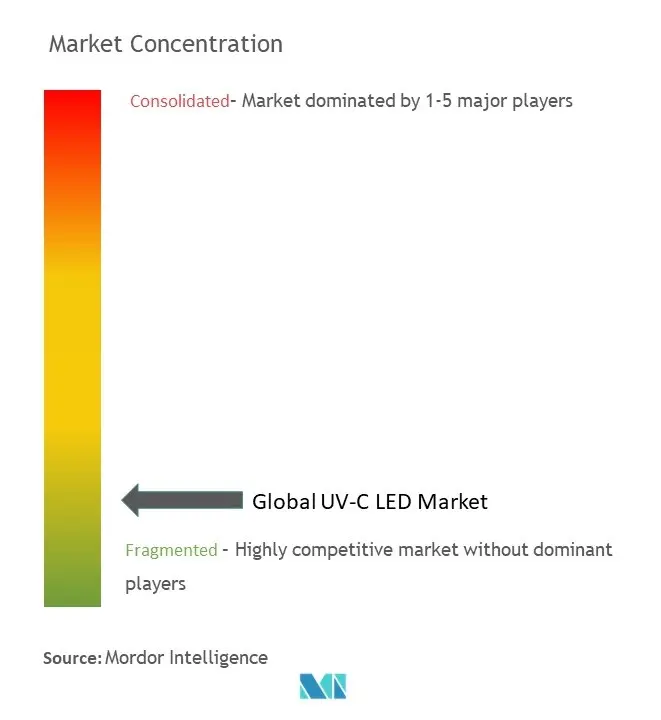
UV-C LED Market News
- October 2022: Seoul Viosys announced that its Violeds technology has been officially certified to eliminate 99.9% of harmful viruses and is applied to KT’s AI disinfection robots. Violeds for KT’s AI disinfection robots prevent germs and bacteria growth with UV LEDs. In February 2022, the Virosis Lab of the Korea University College of Medicine and the Seoul Viosys tested Violeds technology. The results showed that 99.99% of SARS-CoV-2 variant B.1.1.529 are removed within a second.
- September 2022: Nichia continued to launch the UV-C LED technology with the release of its high output wavelength of 280 nm NCSU434C. With its small 3.5 mm x 3.5 mm size, the NCSU434C has industry-leading radiant flux (110 mW) and wall-plug efficiency (5.4%) when compared to a UV-C LED of the same size, an ~80% flux improvement over its predecessor.
UV-C LED Market Report - Table of Contents
1. INTRODUCTION
1.1 Study Assumptions and Market Definition
1.2 Scope of the Study
2. RESEARCH METHODOLOGY
3. EXECUTIVE SUMMARY
4. MARKET INSIGHTS
4.1 Market Overview
4.2 Impact of COVID-19 on the Market
4.3 Industry Attractiveness - Porter's Five Forces Analysis
4.3.1 Bargaining Power of Suppliers
4.3.2 Bargaining Power of Buyers
4.3.3 Threat of New Entrants
4.3.4 Threat of Substitutes
4.3.5 Intensity of Competitive Rivalry
4.4 Pricing Analysis
4.5 Overall UV Lamp Analysis
4.6 UV-C LED Technology - Manufacturing Process
5. MARKET DYNAMICS
5.1 Market Drivers
5.1.1 UV-C LED is Highly Effective for Disinfection
5.1.2 Surge in Adoption of Water Purification
5.2 Market Restraints
5.2.1 Thermal Management of UV-C LED
6. MARKET SEGMENTATION (MARKET SIZE BY VALUE AND VOLUME)
6.1 By Application
6.1.1 Surface Disinfection
6.1.2 Air Disinfection
6.1.3 Water Disinfection
6.2 By Geography
6.2.1 Americas
6.2.2 Asia Pacific
6.2.3 Europe, Middle East, and Africa
7. COMPETITIVE LANDSCAPE
7.1 Company Profiles
7.1.1 NKFG Corporation
7.1.2 Nitride Semiconductor Co. Ltd
7.1.3 Samsung Electronics Co. Ltd
7.1.4 Lumex Inc. (ITW Inc.)
7.1.5 Crystal IS Inc. (Asahi Kasei Group)
7.1.6 Seoul Viosys Co. Ltd
7.1.7 Hongli Zhihui Group
7.1.8 LiteOn Technology Corporation
7.1.9 Luminus Inc.
7.1.10 AMS-Osram AG
7.1.11 International Light Technologies Inc.
7.1.12 Nichia Corporation
- *List Not Exhaustive
8. VENDOR MARKET SHARE ANALYSIS
9. FUTURE OUTLOOK OF THE MARKET
UV-C LED Industry Segmentation
Short-wavelength ultraviolet (UV-C) light is used in UV-C LEDs, a disinfection technique, to kill or inactivate microorganisms by destroying their nucleic acids and disrupting their DNA, preventing them from performing essential cellular functions. As a result, microorganisms lose their ability to reproduce and are killed. Since microorganisms cannot develop immunity to UV radiation, UV-C LEDs have a germicidal effect that treats microorganisms that have developed resistance to chemical disinfectants. Applications for UV-C LEDs include the purification of food, surface, air, and water.
The report considers the demand for UV-C LED products used in various applications, including surface, air, and water disinfection. It also analyzes revenue accrued through UV-C LED product sales and demand across several regions, including the Americas, Asia-Pacific, Europe, and the Middle East and Africa. The study comprises an estimation of the market size in terms of volume and value. It further analyzes the overall impact of COVID-19 on the market ecosystem. The report offers market forecasts and size in volume (million units) and value (USD million) for all the above segments.
| By Application | |
| Surface Disinfection | |
| Air Disinfection | |
| Water Disinfection |
| By Geography | |
| Americas | |
| Asia Pacific | |
| Europe, Middle East, and Africa |
UV-C LED Market Research FAQs
How big is the UV-C LED Market?
The UV-C LED Market size is expected to reach USD 0.3 billion in 2023 and grow at a CAGR of 32.28% to reach USD 1.21 billion by 2028.
What is the current UV-C LED Market size?
In 2023, the UV-C LED Market size is expected to reach USD 0.3 billion.
Who are the key players in UV-C LED Market?
NKFG Corporation, Samsung Electronics Co. Ltd, Lumex Inc. (ITW Inc.), Crystal IS Inc. (Asahi Kasei Group) and Seoul Viosys Co. Ltd are the major companies operating in the UV-C LED Market.
Which is the fastest growing region in UV-C LED Market?
North America is estimated to grow at the highest CAGR over the forecast period (2023-2028).
Which region has the biggest share in UV-C LED Market?
In 2023, the Asia-Pacific accounts for the largest market share in the UV-C LED Market.
UV-C LED Industry Report
Statistics for the 2023 UV-C LED market share, size and revenue growth rate, created by Mordor Intelligence™ Industry Reports. UV-C LED analysis includes a market forecast outlook to 2028 and historical overview. Get a sample of this industry analysis as a free report PDF download.
